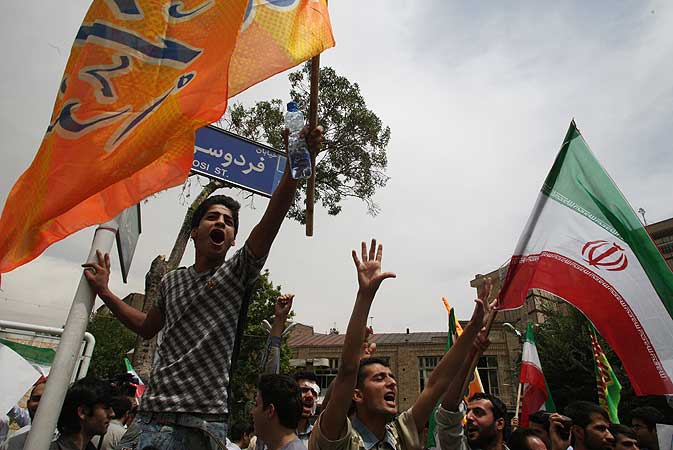UPDATES
Internal strife in Iran – time for more tyrants to fall?
July 7, 2011 | Daniel Meyerowitz-Katz

Whether it was slaughter of innocents in its strong ally, Syria, or proxy attacks on US and allied forces in Iraq, Iran has been making its presence felt throughout the Middle East in recent weeks. What is, perhaps, less widely reported is that the Islamic Republic has been seeing a significant amount of strife itself. One example of almost completely unreported violence inside Iran is the recent suppression of an emerging resistance movement in the Southern region of Ahwaz. MEMRI has translated an interview from London’s Al-Sharq Al-Awsat of an Ahwazi official describing what has been happening:
Ahwaz Liberation Organization official Khaled Al-Khazraji told the London daily Al-Sharq Al-Awsat that the residents of the Ahwaz region in southwestern Iran have continued their resistance to the Iranian regime since the Day of Rage on April 14, and that the regime responded by killing thousands of residents by means of Iran’s Islamic Revolutionary Guard Corps (IRGC). Al-Khazraji said that the Ahwazi struggle for independence is inspired by popular revolutions in the Arab world, and expressed hope that Arab countries will feel a duty to assist them in their struggle for independence. He expressed his support for the Syrian protestors’ demands to oust the Assad regime, and called on the media and Arab countries not to ignore the Ahwazi struggle.
Middle East scholar Michael Ledeen has written an excellent blog post, giving an extremely comprehensive overview of the current situation regarding Iran. As he notes, it is very difficult for information to leave Iran, due to the brutal suppression of the media, however reports have been surfacing in drips and drabs of the many issues currently facing the country:
The direct slaughter at home is not so well covered in the popular press, but Iranians see it every day. Over the weekend, more than fifty executions were publicly announced, and poor souls are rounded up for outrageous prison terms. Crackdowns on “immoral” behavior (the wrong sort of haircut, the wrong sort of head scarf) are intensifying, and women are now forbidden to enter coffee and tea bars where hookahs are in use.
Have a look at this interview with one of the country’s leading human rights lawyers, who was sentenced to nine years’ imprisonment. He told the interviewer he felt fortunate to have escaped with his life.
Ledeen goes on to describe the current enmity that is being displayed between leading figures in the Iranian regime, as well as the terrible economic climate that Iranians are living in and the struggles of Iranian workers:
I have long thought that [Supreme Leader Ayatollah] Khamenei and [President Mahmoud] Ahmadinejad were fused somewhere below the ribs, and would not be foolish enough to engage in public combat. I may have to reconsider. As we used to say in the old days, the objective situation is very revolutionary, and the people are openly contemptuous of the regime. The economy is so bad that the Central Bank has been forbidden to release official data on inflation and other key indicators-a sure sign that the actual numbers are considerably worse than the official ones (knowledgeable sources tell me that real inflation is well over 50%). And favoritism for the mullahs-and-commanders-of-industry is so blatant that workers are getting the back of the regime’s gnarled hand… The misery of Iranian workers-in its most dramatic manifestation, the arrest and ongoing torture of Mansour Osanloo, the president of the Tehran Bus Drivers’ Organization-has come to the attention of Western trade unionists, and the Teamsters recently made Osanloo an honorary member, and called for their counterparts around the world to support him and his followers.
Ledeen concludes with a damning condemnation of the current Western policy towards Iran. I would encourage all of our readers to look at the original piece in order to understand all of the points that he makes.
Meanwhile, columnist Michael Freund has written a timely reminder of the need to prevent Iran from gaining nuclear capabilities in today’s Jerusalem Post:
With the world riveted by protests in Syria and the uprising in Libya, everyone seems to have forgotten the most important issue: Iran’s breathless pursuit of nuclear weapons. But the dearth of attention in no way reflects a lessening of the threat, as the ayatollahs march steadily closer to developing an atomic arsenal.
We all know full well what they plan to do with such weapons should they succeed in building them, as Iranian President Mahmoud Ahmadinejad has made abundantly clear.
.. It should be obvious that an atomic Iran would undermine the stability of the entire region, bolster radical anti-Western forces, and raise the possibility of terrorist groups allied to Tehran, such as Hamas and Hezbollah, getting their hands on the most devastating of weapons.
The bottom line is that Iran can and must be stopped.
With the Iranian regime seeming to be tearing itself apart from the inside, the Iranian people becoming increasingly resistant to their oppressors and the tide turning against dictators throughout the Middle East, it is hard to imagine a better time for change to come to the Islamic Republic. If we miss this window and fail to prevent a nuclear Iran, the ramifications for the Iranian people and the world do not bear thinking about. It is imperative that our policy makers recognise the threat emanating from Iran and do everything in their power to prevent the Ayatollahs’ regime acquiring nuclear weapons.
Daniel Meyerowitz-Katz
Tags: Iran





